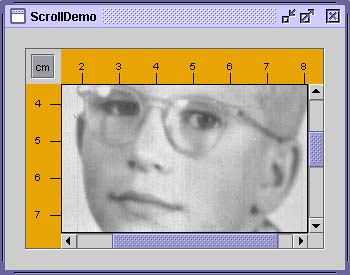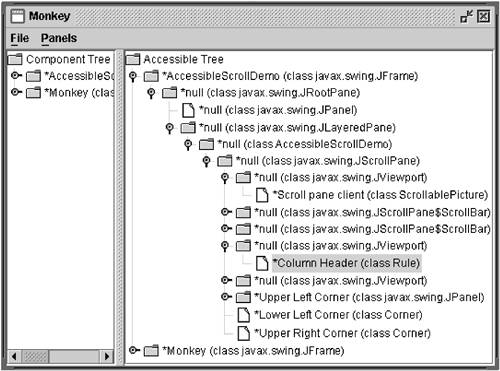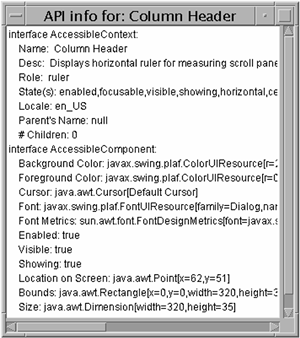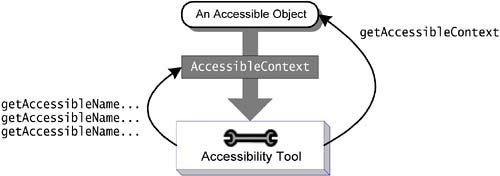How to Support Assistive Technologies
| < Day Day Up > |
| You might be wondering what assistive technologies are and why you should care. Primarily, assistive technologies enable people with disabilities to use the computer. Say you get carpal tunnel syndrome. You can use assistive technologies to accomplish your work without using your hands. Assistive technologiesvoice interfaces, screen readers, alternate input devices, and so onare useful not only for people with disabilities but also for people using computers in non-office environments. For example, you might use assistive technology to check your email when you're stuck in a traffic jam, using only voice input and output. The information that enables assistive technologies can be used for other tools as well, such as automated GUI testers and input devices like touchscreens. Assistive technologies get information from components using the Accessibility API, which is defined in the javax.accessibility package. [5]
Because support for the Accessibility API is built into the Swing components, your Swing program will probably work just fine with assistive technologies, even if you do nothing special. For example, assistive technologies can automatically get the text information that's set by the following lines of code: JButton button = new JButton("I'm a Swing button!"); label = new JLabel(labelPrefix + "0 "); label.setText(labelPrefix + numClicks); JFrame frame = new JFrame("SwingApplication"); They can also grab the tool-tip text (if any) associated with a component and use it to describe the component to the user . Making your program function smoothly with assistive technologies is easy and in the United States may be required by federal law. For more information, see Global Legal Resources for IT Related Accessibility Issues at: http://www.sun.com/access/background/laws.html. Rules for Supporting AccessibilityHere are a few things you can do to make your program work as well as possible with assistive technologies:
Testing for AccessibilityThe examples that come with the accessibility utilities can give you an idea of how accessible your program is. For instructions on getting these utilities, see the JFC Assistive Technologies home page at http://java.sun.com/products/jfc/accessibility/. Follow the instructions in the documentation for setting up the Java Virtual Machine (VM) to run one or more of the utilities automatically. Let's use an accessibility utility to compare the original version of one of our demos to a version in which the rules for supporting accessibility have been applied. Figure 3 is a picture of a program called ScrollDemo . Figure 3. A screenshot of the ScrollDemo example. Try This:
Figure 4 shows Monkey running on ScrollDemo . The left side of the split pane shows the actual component hierarchy for the program. The right side shows the accessible components in the hierarchy, which is what interests us. Figure 4. Monkey running on an inaccessible version of ScrollDemo The first thing to notice is that, even with no explicit support in ScrollDemo , Monkey is able to discover a lot of information about the various components in the example. Most of the components and their children appear in the tree. However, the names for most of them are empty (null), which is rather unhelpful. The descriptions are also empty. Further trouble comes with the program's custom components. The two rulers are inaccessible, so they aren't included in the accessible tree. The viewports that contain the rulers are displayed as leaf nodes because they have no accessible children. The custom corners are also missing from the accessible tree. Figure 5 shows the Monkey window for AccessibleScrollDemo . Figure 5. Monkey running on an accessible version of ScrollDemo . The rules are now listed as children of the viewports, and the corners are listed as children of the scroll pane. Furthermore, many of the components now have non-null names. In Figure 5, the Column Header item is selected. Monkey highlights the corresponding component in the ScrollDemo program. When an item is selected, you can use Monkey's Panels menu to bring up one of four different panels that let you interact with the selected component. Choosing Panels > Accessibility API panel brings up a panel like the one that is shown in Figure 6. This panel displays information available through methods defined in the AccessibleContext base class and the AccessibleComponent interface. Figure 6. An Accessibility API panel. Monkey has three other panels:
The accessibility utilities examples are handy as testing tools and can give you an idea of how accessible the components in your program are. However, even if your components behave well in Monkey or the other examples, they still might not be completely accessible because Monkey and the other examples exercise only certain portions of the Accessibility API. The only true test of accessibility is to run your programs with real-world assistive technologies. Setting Accessible Names and Descriptions on ComponentsGiving your program's components accessible names and descriptions is one of the easiest and most important steps in making your program itself accessible. Following is a complete listing of the AccessibleScrollDemo constructor that creates the scroll pane and the custom components it uses. The boldface statements give component names and descriptions that assistive technologies can use. public AccessibleScrollDemo() { // Get the image to use. ImageIcon david = createImageIcon("images/youngdad.jpeg", "Photograph of David McNabb in his youth."); // Create the row and column headers. columnView = new Rule(Rule.HORIZONTAL, true); if (david != null) { columnView.setPreferredWidth(david.getIconWidth()); } else { columnView.setPreferredWidth(320); } columnView.getAccessibleContext(). setAccessibleName("Column Header"); columnView.getAccessibleContext(). setAccessibleDescription("Displays horizontal ruler for " + "measuring scroll pane client."); rowView = new Rule(Rule.VERTICAL, true); if (david != null) { rowView.setPreferredHeight(david.getIconHeight()); } else { rowView.setPreferredHeight(480); } rowView.getAccessibleContext().setAccessibleName("Row Header"); rowView.getAccessibleContext(). setAccessibleDescription("Displays vertical ruler for " + "measuring scroll pane client."); // Create the corners. JPanel buttonCorner = new JPanel(); isMetric = new JToggleButton("cm", true); isMetric.setFont(new Font("SansSerif", Font.PLAIN, 11)); isMetric.setMargin(new Insets(2,2,2,2)); isMetric.addItemListener(this); isMetric.setToolTipText("Toggles rulers' unit of measure " + "between inches and centimeters."); buttonCorner.add(isMetric); //Use the default FlowLayout buttonCorner.getAccessibleContext(). setAccessibleName("Upper Left Corner"); String desc = "Fills the corner of a scroll pane " + "with color for aesthetic reasons."; Corner lowerLeft = new Corner(); lowerLeft.getAccessibleContext(). setAccessibleName("Lower Left Corner"); lowerLeft.getAccessibleContext().setAccessibleDescription(desc); Corner upperRight = new Corner(); upperRight.getAccessibleContext(). setAccessibleName("Upper Right Corner"); upperRight.getAccessibleContext().setAccessibleDescription(desc); // Set up the scroll pane. picture = new ScrollablePicture(david, columnView.getIncrement()); picture.setToolTipText(david.getDescription()); picture.getAccessibleContext().setAccessibleName( "Scroll pane client"); JScrollPane pictureScrollPane = new JScrollPane(picture); pictureScrollPane.setPreferredSize(new Dimension(300, 250)); pictureScrollPane.setViewportBorder( BorderFactory.createLineBorder(Color.black)); pictureScrollPane.setColumnHeaderView(columnView); pictureScrollPane.setRowHeaderView(rowView); // In theory, to support internationalization you would change // UPPER_LEFT_CORNER to UPPER_LEADING_CORNER, // LOWER_LEFT_CORNER to LOWER_LEADING_CORNER, and // UPPER_RIGHT_CORNER to UPPER_TRAILING_CORNER. In practice, // bug #4467063 makes that impossible (at least in 1.4.0). pictureScrollPane.setCorner(JScrollPane.UPPER_LEFT_CORNER, buttonCorner); pictureScrollPane.setCorner(JScrollPane.LOWER_LEFT_CORNER, lowerLeft); pictureScrollPane.setCorner(JScrollPane.UPPER_RIGHT_CORNER, upperRight); // Put it in this panel. setLayout(new BoxLayout(this, BoxLayout.LINE_AXIS)); add(pictureScrollPane); setBorder(BorderFactory.createEmptyBorder(20,20,20,20)); } Often the program sets a component's name and description directly through the component's accessible context. Other times, it sets an accessible description indirectly with tool tips. In the case of the cm toggle button, the description is set automatically to the text on the button. How Accessibility WorksAn object is accessible if it implements the Accessible [9] interface. The Accessible interface defines just one method, getAccessibleContext , which returns an Accessible-Context [10] object (see Figure 7). This object is an intermediary that contains the accessible information for an accessible object.
Figure 7. This figure shows how assistive technologies get the accessible context from an accessible object and query it for information. AccessibleContext is an abstract class that defines the minimum information an accessible object must provide about itself. That minimum includes name, description, role, state set, and so on. To identify its accessible object as having particular capabilities, an accessible context can implement one or more of the interfaces as shown in Table 6, "Accessible Interfaces," on page 533. For example, JButton implements AccessibleAction , Accessible-Value , AccessibleText , and AccessibleExtendedComponent . It isn't necessary for JButton to implement AccessibleIcon , which is implemented by the ImageIcon attached to the button. Because the JComponent class itself doesn't implement the Accessible interface, instances of its direct subclasses aren't accessible. If you write a custom component that inherits directly from JComponent , you need to explicitly make it implement the Accessible interface. JComponent does have an accessible context, called AccessibleJComponent , that implements the AccessibleComponent interface and provides a minimal amount of accessible information. You can provide an accessible context for your custom components by creating a subclass of AccessibleJComponent and overriding important methods. The next section, Making Custom Components Accessible, shows two examples of doing this. All of the other standard Swing components implement the Accessible interface and have an accessible context that implements one or more of the preceding interfaces as appropriate. The accessible contexts for Swing components are implemented as inner classes and have names of this style: Component .Accessible Component If you create a subclass of a standard Swing component and your subclass is substantially different from its superclass, you should provide a custom accessible context for it. The easiest way is to create a subclass of the superclass's accessible context class and override methods as necessary. For example, if you create a JLabel subclass substantially different from JLabel , your subclass should contain an inner class that extends AccessibleJLabel . The next section shows how to do this using examples in which JComponent subclasses extend AccessibleJComponent . Making Custom Components AccessibleThe ScrollDemo program uses three custom component classes. ScrollablePicture is a subclass of JLabel , and Corner and Rule are both subclasses of JComponent . The ScrollablePicture class relies completely on accessibility inherited from JLabel through JLabel.AccessibleJLabel . [11] The code that creates an instance of Scrollable-Picture sets the tool-tip text for the scrollable picture. The tool-tip text is used by the context as the component's accessible description. This behavior is provided by AccessibleJLabel .
The accessible version of the Corner class contains just enough code to make its instances accessible. We implemented accessibility support by adding the code shown in bold to the original version of Corner in the following. public class Corner extends JComponent implements Accessible { public void paintComponent(Graphics g) { //Fill me with dirty brown/orange. g.setColor(new Color(230, 163, 4)); g.fillRect(0, 0, getWidth(), getHeight()); } public AccessibleContext getAccessibleContext() { if (accessibleContext == null) { accessibleContext = new AccessibleCorner(); } return accessibleContext; } protected class AccessibleCorner extends AccessibleJComponent { //Inherit everything, override nothing. } } All of the accessibility provided by this class is inherited from AccessibleJComponent , [12] which is fine for Corner because AccessibleJComponent provides a reasonable amount of default accessibility information and because corners are uninterestingthey exist only to take up a little bit of space onscreen. Other classes, such as Rule , need to provide customized information.
Rule provides an accessible context for itself in the same manner as Corner , but the context overrides two methods to provide details about the component's role and state: protected class AccessibleRuler extends AccessibleJComponent { public AccessibleRole getAccessibleRole() { return AccessibleRuleRole.RULER; } public AccessibleStateSet getAccessibleStateSet() { AccessibleStateSet states = super.getAccessibleStateSet(); if (orientation == VERTICAL) { states.add(AccessibleState.VERTICAL); } else { states.add(AccessibleState.HORIZONTAL); } if (isMetric) { states.add(AccessibleRulerState.CENTIMETERS); } else { states.add(AccessibleRulerState.INCHES); } return states; } } AccessibleRole [13] is an enumeration of objects that identify the roles that Swing components can play. It contains predefined roles such as label and button. The rulers in our example don't fit well into any of the predefined roles, so the program invents a new ruler in a subclass of AccessibleRole :
class AccessibleRuleRole extends AccessibleRole { public static final AccessibleRuleRole RULER = new AccessibleRuleRole("ruler"); protected AccessibleRuleRole(String key) { super(key); } //Should really provide localizable versions of these names. public String toDisplayString(String resourceBundleName, Locale locale) { return key; } } Any component that has state can provide state information to assistive technologies by overriding the getAccessibleStateSet method. A rule has two sets of states: Its orientation can be either vertical or horizontal, and its units of measure can be either centimeters or inches. AccessibleState [14] is an enumeration of predefined states. This program uses its predefined states for vertical and horizontal orientation. Because AccessibleState contains nothing for centimeters and inches, the program makes a subclass to provide appropriate states:
class AccessibleRulerState extends AccessibleState { public static final AccessibleRulerState INCHES = new AccessibleRulerState("inches"); public static final AccessibleRulerState CENTIMETERS = new AccessibleRulerState("centimeters"); protected AccessibleRulerState(String key) { super(key); } //Should really provide localizable versions of these names. public String toDisplayString(String resourceBundleName, Locale locale) { return key; } } You've seen how to implement accessibility for two simple components, which exist only to paint themselves onscreen. Components that do more, such as respond to mouse or keyboard events, need to provide more elaborate accessible contexts. You can find examples of implementing accessible contexts by delving into the source code for the Swing components. The Accessibility APITables 4 through 6 cover just part of the accessibility API. For more information, see the API documentation for the classes and packages in the accessibility package. Also, refer to the API documentation for the accessible contexts for individual Swing components. You can find the javax.accessibility API documentation online at: http://java.sun.com/j2se/1.4.2/docs/api/javax/swing/accessibility/package-summary.html. Table 4. Naming and Linking Components
Table 5. Making a Custom Component Accessible
Table 6. Accessible Interfaces
Examples That Use the Accessibility APIThe following table lists some examples that have good support for assistive technologies.
|
| < Day Day Up > |
EAN: 2147483647
Pages: 171




